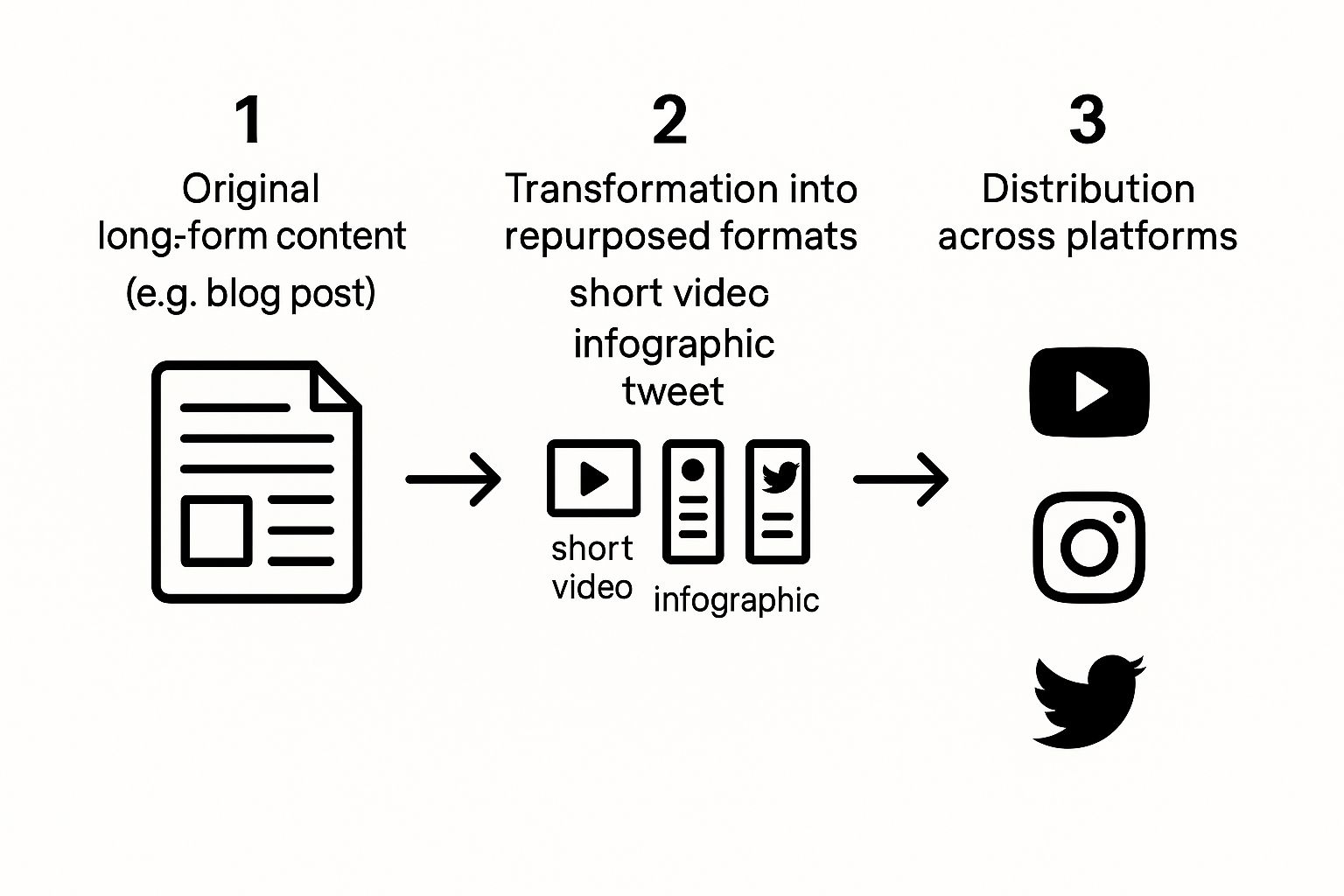Reach People You'd Otherwise Miss
Think about it: every social media platform is its own little world with a unique audience and culture.
- LinkedIn: People are there for professional development and deep-dive industry insights.
- Instagram: It's all about visuals—eye-catching carousels, Reels, and strong imagery.
- Twitter (X): This is the home of quick, punchy tips and shareable takeaways.
By tailoring your core content to fit the native format of each platform, you can connect with entirely new segments of your audience on their own turf. Your original blog post can't do that alone, but all of its repurposed offshoots can.
This isn't just a hunch; the numbers back it up. One 2025 study found that a staggering 94% of marketers are now actively repurposing content. And here’s the real kicker: 42% of them say it’s a key reason for their overall marketing success. That's powerful proof that this strategy works to expand your reach. You can dig into more of these findings on modern marketing strategies on circleboom.com.
How to Find Your Content Goldmine

Before you dive into the fun, creative work of adapting content for social media, you need a smart way to sift through what you've already got. Let's be honest: not every blog post or video in your archive is a hidden gem. The real trick is knowing how to spot the pieces with the highest potential for a second life on social platforms.
So, where do you start digging? The first place I always look is for evergreen content. These are the timeless pieces that stay relevant and valuable long after you hit publish. Think of something like "The Ultimate Guide to Brewing Better Coffee at Home." It's not tied to a specific trend or news event and will keep pulling in readers for years. On the other hand, a post announcing a Black Friday sale from three years ago is a dead end for repurposing.
Fire up your analytics and look for the quiet performers—the posts that consistently bring in traffic month after month, even if they're old. These are your foundational assets, just waiting to be mined for social media gold.
Identify Your Highest-Engagement Pieces
Okay, you've got a list of your timeless hits. Now, let's narrow it down by finding what already gets people talking. You're searching for content that didn't just get clicks; it sparked actual human interaction. This is your clearest signal that the core topic truly connects with your audience on a deeper level.
What does this engagement look like in the wild?
- High Comment Volume: Find the blog posts that turned into lively discussions in the comments section.
- Exceptional Share Counts: Any content that people loved so much they had to share it with their own networks is a proven winner.
- Strong Backlink Profile: When other credible sites link to your content, it’s a stamp of approval. This signals authority and value that you can definitely translate to social media.
These metrics are your cheat sheet. They tell you which topics have the best shot at performing well when you slice and dice them for different platforms. That blog post that kicked off a huge debate? It's perfect material for a provocative LinkedIn post or a fiery Twitter thread.
Here’s a pro tip: Don't get mesmerized by traffic alone. A post can get thousands of views but have zero comments or shares. That usually means you wrote a killer headline, but the content itself fell flat. Always prioritize the assets that proved they could build a community, not just attract eyeballs.
Prioritize Your Cornerstone Content
Finally, it's time to zero in on your cornerstone content. These are the big, comprehensive pieces that establish you as an expert in your field. I'm talking about your ultimate guides, original research reports, or incredibly detailed case studies. They're way too dense to just copy and paste onto social media, but they are by far the richest source for new material.
Think of each cornerstone article as a content tree with dozens of branches. A single 3,000-word guide can easily fuel an entire month's worth of social media posts.
Take a comprehensive guide to email marketing, for instance. You could spin that one piece into:
- An Instagram carousel showcasing 5 surprising stats from your research.
- A series of LinkedIn posts, with each one doing a deep-dive on a single chapter from the guide.
- A Twitter thread that boils down the top 10 takeaways into bite-sized tips.
- A short, snappy TikTok video demonstrating one specific tactic you wrote about.
By systematically identifying your evergreen, high-engagement, and cornerstone content, you're not just making a random list of old posts. You're building a strategic inventory of proven assets. This gives your plan for repurposing content for social media the absolute best chance to succeed right out of the gate.
To help you with this process, I've put together a quick checklist.
Content Goldmine Identification Checklist
Use this table as a quick reference guide to help you evaluate which existing content pieces have the highest potential for successful repurposing on social media. It helps you look past simple traffic numbers and focus on the characteristics of content that truly performs.
| Content Characteristic |
What to Look For |
Example Metric to Track |
| Evergreen Appeal |
Content that isn't tied to a specific date, event, or trend. Its advice remains useful over time. |
Consistent month-over-month organic traffic for posts older than 6 months. |
| High Engagement |
Content that sparked conversations, debates, and shares. It proves the topic resonates. |
High number of comments on the original post; social share counts above your average. |
| Cornerstone Authority |
Comprehensive, in-depth guides, original research, or detailed "how-to" articles. |
High word count (e.g., over 2,500 words); significant number of backlinks from other sites. |
| Proven Conversion |
Content that successfully drove a specific action, like a download, sign-up, or inquiry. |
High click-through rate on internal calls-to-action (CTAs); goal completions in Google Analytics. |
By checking your content against these points, you can confidently prioritize the pieces that will give you the most bang for your buck on social media. It's all about working smarter, not harder.
Turning One Asset Into a Week of Content
Alright, you've pinpointed a high-performing piece of content. Now for the fun part. This is where we shift from planning to doing, taking that single asset and spinning it into a full week's worth of social media gold. The secret isn't just to copy and paste—it's to adapt everything thoughtfully.
Repurposing content for social media has gone from a "nice-to-have" to a core strategy for smart brands. The idea is to break down your long-form content into smaller, more digestible pieces. Think turning text into videos, stats into infographics, or pulling out evergreen quotes for standalone posts. This saves an incredible amount of time and resources, all while getting your best ideas in front of more people. If you want a deeper dive, there are some great insights on adapting content for social media over at schedulethreads.com.
What you're really doing is making sure every post feels like it belongs on the platform where you share it. It needs to fit right in with how people on that specific app expect to see information.
From Blog Post to Multi-Platform Campaign
Let’s walk through a real-world example. Imagine you have a 2,000-word cornerstone blog post called "10 Advanced SEO Techniques to Triple Your Traffic." It's packed with value, but it's also dense. Here’s how you could break it down.
For LinkedIn: This audience is here for professional development and sharp insights. You could easily create a series of five thought-leadership posts. Take two SEO techniques for each post, write a solid summary, and end with a provocative question to get a discussion going. You’re not just link-dropping; you're building authority.
For Instagram: It’s all about the visuals here. That meaty blog post can become a clean, compelling 10-slide carousel. Each slide gets one SEO technique, a bold headline, a simple icon, and a single sentence of explanation. The caption is your call-to-action, pushing people to the full article for more detail.
This visual shows exactly how that flow works—one core piece of content, transformed and distributed across channels where it makes the most sense.

As you can see, the central idea is consistent. It's the delivery that changes to match the user's experience on each platform.
Adapting for Short-Form and Visual Platforms
But we don't have to stop there. That single blog post has even more potential when you start thinking about other formats.
For Twitter (X): Speed and shareability are everything on X. Turn your article into a Twitter thread that breaks down all 10 techniques with short, punchy descriptions. Pin that thread to your profile for a few days, and then pull out individual tips to post as standalone tweets throughout the week.
For Pinterest: Think of Pinterest as a visual search engine. Pull out the most data-driven or process-heavy sections of your blog and design a tall, eye-catching infographic. For our SEO example, an infographic that visualizes the traffic impact of each technique would be perfect for driving clicks from Pinterest.
For Facebook and Instagram Reels: Pick one or two of the most actionable tips from your post. Film a quick 30-second video talking directly to the camera, explaining the tip, and maybe even showing a quick screen recording of how to do it. It's a fantastic way to put a face to your brand and deliver value instantly.
Here's the key takeaway: Successful repurposing is about adaptation, not duplication. You want someone on LinkedIn to see your post and think, "This is great LinkedIn content," not, "Oh, this is just a chopped-up blog post."
Every social platform has its own unwritten rules and user mindset. When you respect those nuances, you multiply the impact of every single piece of content you create.
Thinking Beyond the Social Media Feed

Smart repurposing is so much more than just scheduling a few posts for your feed. Sure, turning a blog post into a carousel or a Twitter thread is a great start, but the real growth happens when you start thinking bigger. We're talking about transforming your best work into major assets that build genuine authority and actively bring in leads.
When you repurpose content for social media effectively, you're not just creating posts—you're leveling up your content into high-value, long-term assets. This is how you stretch your content's shelf life from a couple of days to several years, cementing your reputation as the go-to expert in your niche.
From Blog Posts to Lead-Generating eBooks
Let's say you've written three to five related blog posts that all explore different facets of the same core subject. Maybe they cover "Choosing the Right Email Platform," "Writing Killer Subject Lines," and "Analyzing Your Open Rates." On their own, they're useful articles. But when you weave them together? They become something far more powerful.
You can combine these cornerstone pieces into a single, comprehensive eBook. This isn't a simple copy-paste job. It’s about crafting a proper introduction, creating smooth transitions between what will now be chapters, and designing a polished, professional cover. Suddenly, you have an irresistible lead magnet you can offer in exchange for an email address, growing your list with people who are genuinely interested in what you have to say.
A solid social media strategy for small business often relies on creating these kinds of downloadable resources. It gives your audience a concrete reason to connect with you that goes way beyond a simple "follow." For more on this, check out our guide on building a social media strategy for small business.
Convert High-Performers Into Webinars and Video Series
Now, let's look at a different type of asset. Take a high-performing case study or an "ultimate guide" blog post—content that has already proven its value by pulling in traffic and engagement. What’s its next life? It could be a live webinar or even a multi-part YouTube series.
The process starts by breaking down the case study's story or the guide's key sections into a compelling script. Each point can become a segment in your webinar, supported by slides that showcase data and results. This interactive format lets you connect with your audience in real-time, answer their questions on the spot, and build a much deeper relationship than any static article ever could.
A single piece of content can be the seed for an entire ecosystem of assets. A content marketing analysis highlighted how a single comprehensive blog post can be broken down for social media, transformed into an educational webinar, or combined with other posts to create a lead-generating eBook. This multi-format approach dramatically increases the content’s visibility and overall impact. You can read more about these multi-format content strategies on mariopeshev.com.
Fueling Newsletters and Podcasts
Don't forget about the potential locked inside your articles for fueling channels like email newsletters and podcasts. The most potent insights, stats, or actionable tips from one blog post can easily power an entire email sequence. Each email can dive deeper into one specific idea from the original piece, delivering value directly to your subscribers' inboxes.
In the same way, a well-researched article provides a perfect outline for a podcast episode. You can use the main headings as your talking points, expanding on each with personal stories and extra context. This strategy lets you reach a whole new audience that prefers listening over reading, and you get to do it without ever starting from a blank page.
Building Your Content Repurposing Engine
A great strategy for repurposing content is one thing, but it will quickly fall apart without a solid system to back it up. We’re not talking about occasionally recycling an old post. The real goal is to build an efficient, repeatable workflow that makes repurposing a core part of your marketing—not just a frantic afterthought. Think of it as building a well-oiled machine.
This whole process really kicks off with a dedicated content repurposing calendar. This shouldn't be some separate, forgotten spreadsheet. It needs to live and breathe with your primary content calendar, the one you use for blogs, videos, and podcasts. When you schedule a new cornerstone article to go live, your repurposing calendar should immediately trigger a series of tasks to break that piece down for social media over the coming weeks.
Create Specific Repurposing Briefs
To keep everything consistent, especially if you're working with a team, you’ll want to create simple repurposing-specific content briefs. A brief doesn't have to be some long, drawn-out document. It's just a quick guide that ensures anyone on your team can flawlessly transform an asset for any channel.
For each major piece of content you plan to repurpose, the brief should lay out the essentials:
- Link to the original asset: The source blog post, video, or podcast episode.
- Core message: What's the one single idea we absolutely need to get across?
- Key pull-quotes and stats: Pinpoint the most powerful sentences and data points.
- Target platforms: List exactly where this is going (e.g., LinkedIn, Instagram, Twitter).
- Format requirements: Get specific. Is this "a 5-slide Instagram carousel" or "a 10-tweet thread"?
Taking a few minutes to do this removes all the guesswork. It empowers your team to execute your vision perfectly while maintaining brand voice and quality across every single channel.
Automate the Tedious Work with the Right Tools
Building a true engine means letting tools handle the repetitive, mind-numbing tasks. Your time is much better spent on strategy and creative ideas, not on tedious manual work. Luckily, there are fantastic tools out there to automate almost every part of the repurposing process.
For instance, video editing tools can chop up long-form videos into short, snappy clips perfect for social media in minutes. Graphic design platforms have templates that make creating branded carousels or infographics almost effortless. Of course, a crucial part of any content engine is having solid social media marketing strategies for authors, which can offer some fantastic insights for any creator, not just writers.
When your system is humming along, you'll notice your content workflow feels less like a constant sprint and more like a predictable, manageable rhythm. The right mix of a clear calendar, detailed briefs, and smart automation is what turns good ideas into consistent results.
Finally, you absolutely need a robust scheduling tool. This is non-negotiable. Manually posting across multiple platforms at the best times is a recipe for burnout and inconsistency. To get this part right, you can dive deeper into our guide on how to schedule social media posts and find the perfect approach for your team.
By combining a smart calendar, clear briefs, and the right automation, you build a system that consistently fuels your social channels with proven, high-quality content. This is how you move from random, one-off wins to sustainable, long-term growth.
Answering Your Top Content Repurposing Questions
Even with a great strategy in hand, you're bound to run into some practical questions once you start slicing and dicing your content for social media. It happens to everyone. Let's walk through some of the most common things that trip marketers up and get you the clear, experienced-based answers you need to keep moving.
One of the biggest worries I hear is about timing and frequency. You've created an incredible asset and you want to get the most out of it, but you're nervous about spamming your audience. It's a valid concern, and there’s definitely a sweet spot.
How Often Can I Repurpose a Piece of Content?
There's no single magic number here, but I've found a good rule of thumb is to give a major piece of content a rest for about 3-6 months before you circle back for another major repurposing campaign. This gives your audience enough breathing room so they don't feel like they're seeing the same thing on a loop.
But here’s the important distinction: that rule only applies to big, campaign-level pushes. When it comes to micro-content, the gloves are off.
You can absolutely pull different small snippets—like individual stats, powerful quotes, or quick tips—from that same pillar article far more frequently. For instance, you could share a different quote every few weeks, and no one would ever think you’re being repetitive because the format, hook, and context are completely fresh each time.
A lot of people think repurposing means you can't talk about the same idea twice. The reality is, reinforcing your core message is how you build a brand. Marketing wisdom says a prospect needs to hear something at least seven times to act, so smart repetition is your best friend.
Will I Get Hit With a Duplicate Content Penalty?
This question comes up all the time, and it’s a smart one to ask. The short answer is a resounding no—not when you’re doing it right.
Search engines like Google have gotten incredibly sophisticated. They can easily tell the difference between someone trying to spam their index and a savvy marketer who is adapting a core idea for different platforms.
They understand that a 2,000-word blog post, a 10-slide Instagram carousel, and a punchy Twitter thread are fundamentally different experiences for different audiences. The key is to transform, not just copy-paste. As long as you’re making your content feel native to each channel, you're adding unique value and won't have to worry about penalties.
How Much of the Original Content Should I Change?
My advice is to worry less about changing the words and more about changing the format and tone. The real goal is to make the content feel like it was born on the platform where you’re posting it.
Here’s what that looks like in practice:
- For LinkedIn: You might take a blog section and keep 80% of the original text. The main change would be to write a sharper, more professional hook at the beginning and add a call-to-action that resonates with a business-focused audience.
- For Instagram: You’d do the complete opposite. You might pull just 5-7 key ideas and turn them into eye-catching graphics. The image would have very little text, with the real meat of the message living in the caption.
The degree of change is all about bridging the gap between the original format and the new one. The core message can stay the same, but the delivery has to be tailor-made.
Ready to stop guessing and start generating a month of on-brand social media content in minutes? OutBrand uses AI to instantly create a complete, fully branded content calendar based on your unique goals and audience. Stop the content treadmill and build a powerful, consistent presence effortlessly. Start your journey with OutBrand today.



